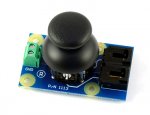Cosmic Software
Member
I am in the process of making a fairly complex system, and have just a couple of queries.
Firstly, I need two variable resistors to make a small joystick, such as on a PS2 controller. I do not know where I can find one of these with springs in, so if anyone knows, it would be helpful. My query regarding using picaxe is the code I must use to interpret the position of the Variable Resistors, to control the direction and speed of the output (2 stepper motors driven by the chips L293D)
My second section that I am stuck on is how I can integrate LEDs into a matrix of buttons, a little like in the keypad project. I have six PTM switchs on 2 outputs and 3 inputs, and when a button is pressed, I want a corresponding LED to come on. When another button is pressed, that LED must go off and another must come on. I do not have any spare outputs on the picaxe chip (18X) and do not want to go any bigger unless absoloutley necessary.
The only solution that I can think of is to have 2 PTMs linked together (mechanically, not electrically); one for the input to the picaxe, and the other to power the LED, linked into a bistable decive such as a thyristor. I am not sure how to turn the LED off however.
Any ideas?
Firstly, I need two variable resistors to make a small joystick, such as on a PS2 controller. I do not know where I can find one of these with springs in, so if anyone knows, it would be helpful. My query regarding using picaxe is the code I must use to interpret the position of the Variable Resistors, to control the direction and speed of the output (2 stepper motors driven by the chips L293D)
My second section that I am stuck on is how I can integrate LEDs into a matrix of buttons, a little like in the keypad project. I have six PTM switchs on 2 outputs and 3 inputs, and when a button is pressed, I want a corresponding LED to come on. When another button is pressed, that LED must go off and another must come on. I do not have any spare outputs on the picaxe chip (18X) and do not want to go any bigger unless absoloutley necessary.
The only solution that I can think of is to have 2 PTMs linked together (mechanically, not electrically); one for the input to the picaxe, and the other to power the LED, linked into a bistable decive such as a thyristor. I am not sure how to turn the LED off however.
Any ideas?

